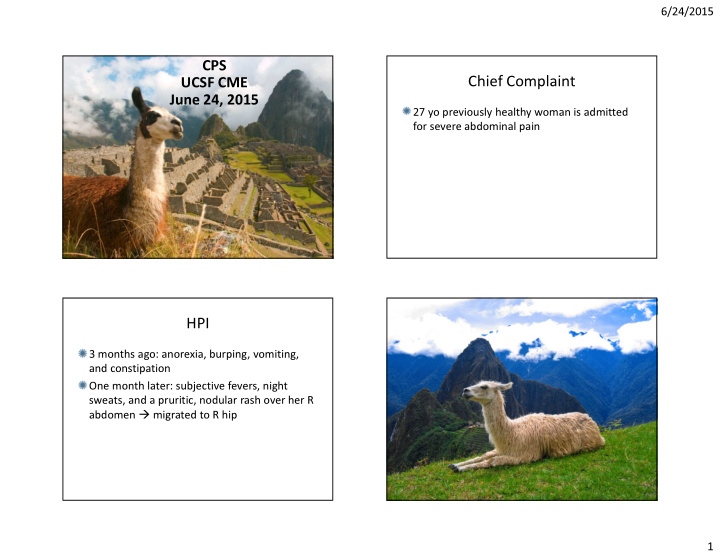



6/24/2015 CPS Chief Complaint UCSF CME June 24, 2015 27 yo previously healthy woman is admitted for severe abdominal pain HPI 3 months ago: anorexia, burping, vomiting, and constipation One month later: subjective fevers, night sweats, and a pruritic, nodular rash over her R abdomen � migrated to R hip 1
6/24/2015 HPI, continued HPI, continued Aforementioned symptoms developed while Exposures in Peru teaching English and yoga Reported intercourse with new male partner (used condom) Swam in dirty water near a zoo in the jungle Travel to GI symptoms Fever, rash (Current Camped and trekked through jungle areas Peru presentation) Walked barefoot on farms at the yoga center Ate ceviche and raw vegetables In Peru HPI, continued Sought medical care in Cuzco (2 months before current presentation): Showed photos of rash to her physician: 2
6/24/2015 HPI, continued CBC with eosinophilia (3000), chem panel and LFTs normal Blood cultures + Salmonella typhi Treated with cipro x10 days � constitutional symptoms resolved But rash and GI symptoms persisted HPI, continued HPI Cont Further w/u for rash and GI sxs (in Cuzco): Upon return, saw PCP � started empiric Rash biopsy: nonspecific inflammatory changes prednisone 40mg daily for possible allergic or Stool O+P negative autoimmune process Repeat WBC 14,000 with 44% eos 3 days after starting prednisone, presents to Treated with ivermectin and triclabendazole local ED with abrupt worsening of abd pain (unclear course) (current presentation) Rash, constipation, and crampy abd pain Travel to GI symptoms Fever, rash Current persisted and she returned to the US for Peru presentation further medical care In Peru 3
6/24/2015 Remainder of history PMH NKDA Mild childhood asthma no intubations Meds no atopic symptoms None, except recently G0P0 Cipro Ivermectin Triclabendazole PSH Prednisone None Remainder of history FHx SHx Mother: leukemia Lives on San Juan Island with her family Otherwise noncontributory Most recently teaching English and yoga in Peru HRB No other travel No tob, etoh, illicits, Exposures as per HPI IVDU 4
6/24/2015 Exam Exam, cont Abd: soft, mild TTP, +rebound, no guarding. VS 36.4 78 100/59 20 98% RA No HSM. Hypoactive BS Gen: pleasant, WDWN, NAD MSK: normal HEENT: anicteric, EOMI, no conj Neuro: A&Ox3, normal hemorrhages. OP clear, MMM Lymph: no supraclavicular or cervical LAD Neck: supple Skin: indurated red/violaceous thick linear CV: RRR, nl S1, S2, no m/r/g rash over R iliac crest. No fluctuance, mild TTP Resp: CTAB and warmth Labs Micro + Imaging HIV, syphilis, GC/CT, and hepatitis serologies 135 106 11 11.3 negative 88 11.7 279 21 0.67 3.9 Repeat O+P negative x3 Blood cultures pending 0.7 Diff: 42% eos 46 108 CT a/p Ca 8.3, Mg 1.6 77 Inflammation of the ileum and adjacent fluid c/f Albumin 3.0 small perf vs abscess PT 14.1, PTT 34, INR 1.1 5
6/24/2015 Hospital course Started on ceftriaxone for possible typhoid relapse (and possible perf) Blood cultures neg Multiple serologies pending Abdominal pain improved, was discharged on azithromycin and a dose of albendazole for possible helminthic infection NOS Outpatient course A diagnostic test was received… Continues to get new nodules on her abdomen Eos persistently elevated Serologies returned: High pos filariasis IgG, neg filariasis IgG4 neg strongyloidiasis Ab Neg fasciola Neg toxocara Neg paragonamous 6
6/24/2015 Final diagnosis? 41% A. Typhoid relapse 22% B. Filariasis 15% 12% C. Echinococcus 5% 5% D. Gnathostomiasis s e s s s s i u i i . s s s . p a c a a i a a c i i w r o m d l a e l c i t r i o o o ’ E. Strongyloidiasis F n d n t l s y a i i o g o h c h n h c – t o p E a a r y n t e T S G d i o n e F. I have no idea – can’t wait for Dr. v a h I Hollander’s answer! Follow-up Email, 1 year later (5/2015) Hello Thankfully, my rash began to slowly disappear about 2 weeks after taking Albendazole. I got a 6-month and 1-year check-up and my Eosinophilia has disappeared! I am back on track, feeling very healthy, alive and parasite free :) I have some very minor discoloration where the rash was and a couple of scars from the Peruvian biopsies, but that's it! Thank you again so much for your expertise, persistence, and incredible support! I don't know what I would have done without you. Regards, 7
6/24/2015 Final diagnosis Gnathostomiasis Map of countries with reported acquisition of gnathostomiasis. Special Acknowledgement • Dr. Seth Cohen – Previous UCSF chief resident, 2012-2013 – Current chief fellow, infectious diseases, UWMC Herman J S , and Chiodini P L Clin. Microbiol. Rev. 2009;22:484-492 8
6/24/2015 Gnathostomiasis Gnathostomiasis Adult worm lives inside gastric wall of definitive host Caused by nematode and expels eggs into GI tract Gnathostoma 1st stage larva hatch in the presence of water and are spinigerum then ingested by intermediate hosts, (small crustaceans) where they mature Acquired by eating Ingested by second intermediate hosts (fish, frogs, snakes, chickens, pigs), migrate and mature into 3 rd uncooked food, esp fish stage larva ready to infect humans (eg ceviche!) Most commonly acquired by consumption of undercooked fish (esp tilapia), poultry or pork Also acquired via penetration of the skin or prenatal transmission Rusnak, CID, 1993 Gnathostomiasis: Clinical Diagnosis: Western blot, performed in Thailand 2 forms of disease, visceral and cutaneous Thought to be sensitive and specific for this disease Cutaneous form: Intermittent migratory skin One study examined a case series from 2000-2001 and subcutaneous swellings, eosinophilia of 16 patients in a Thai hospital CNS involvement (eosinophilic meningitis) Median time from symptoms to diagnosis was 12 Symptoms occur ~24-48hrs after ingestion months with non-specific sx: malaise, fever, Eosinohilia present in 7 patients urticaria Treatment: albendazole 400mg BID x 21 days Migrate through subcutaneous tissue � migratory swellings for up to 10-12 years! Moore, EID, 2003 Rusnak, CID, 1993 9
Recommend
More recommend